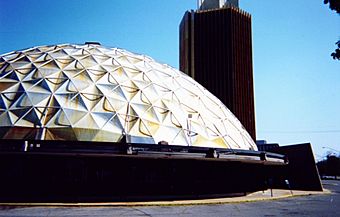Gold Dome facts for kids
Quick facts for kids |
|
|
Citizens State Bank
|
|

The Gold Dome as viewed from Classen Boulevard
|
|
| Location | 1112 NW 23rd Street, Oklahoma City, Oklahoma |
|---|---|
| Built | 1958 |
| Built by | Secor Construction Co. |
| Architect | Bailey, Bozalis, Dickenson & Roloff |
| Architectural style | Modern Movement, Geodesic Dome |
| NRHP reference No. | 03000875 |
| Added to NRHP | September 04, 2003 |
The Gold Dome is a very unique building in Oklahoma City, Oklahoma. It's shaped like a giant half-sphere, which is called a geodesic dome. This special building was finished in 1958. You can find it at the corner of NW 23rd Street and North Classen Boulevard. It's a famous spot along the historic Route 66. In 2002, it was recognized as important enough to be listed on the National Register of Historic Places.
Contents
The Gold Dome's Unique Design
Building a Geodesic Dome
Construction on the Gold Dome started in 1958 for the Citizens State Bank. This building was only the fifth geodesic dome ever built in the world. It was the very first one used as a bank! People called it "one of the nation’s most revolutionary bank designs."
The special geodesic dome shape was invented by a famous thinker and architect named Buckminster Fuller. The architects for the Citizens State Bank, Bailey, Bozalis, Dickinson, and Roloff, used his ideas to create this unusual landmark in Oklahoma City.
How the Dome Was Made
The dome is made up of 625 separate panels. These panels vary in size, from about 7.5 feet to 11.5 feet long. Each panel weighs between 60 and 70 pounds. The entire dome stretches across a diameter of about 145 feet. Inside, the building covers a large area of about 27,000 square feet. Building the Gold Dome bank cost around $1 million at the time.
The Gold Dome's History
Protecting Unique Buildings
In 1998, the Oklahoma City Government wanted to protect special buildings along NW 23rd Street. This area included the Gold Dome. They wanted to keep the unique look and business feel of the street. This street is located between other important historic areas.
The city planned a new rule for this area. Property owners would need permission from a special design board. This permission would be needed before they could tear down or change buildings.
Efforts to Save the Dome
In 2001, a bank called Bank One owned the Gold Dome. They wanted to tear it down. The bank said the building was too big for their needs. They also said it would cost too much to fix it up, estimating about $1.7 million. Bank One planned to sell the land to Walgreens, a pharmacy.
A group of people called "Citizens for the Golden Dome" formed to save the building. They asked Bank One not to tear it down. They highlighted its unique history and how it added to Oklahoma City's character. They also suggested getting it listed on the National Register of Historic Places.
A Community Rallies
In August 2001, Bank One offered other ideas instead of demolition. They suggested building a smaller bank next to the Gold Dome. The bank gave people 60 days to find a buyer who wanted to save the building.
The State Historic Preservation Office agreed that the building was important enough for landmark status. This was special because buildings usually need to be at least 50 years old for this status.
A company named Blue Stuff showed interest in buying the Gold Dome. They needed a bigger space and thought the building wouldn't be as expensive to fix as Bank One claimed.
People tried many ways to save the Gold Dome. They held protests and marches. In September 2001, a couple even wrote a song about it! A company called Sonic Drive-In restaurants helped too. They put a message on their billboard across from the Gold Dome. It said, "Stop the demolition of our historic landmark." It also listed phone numbers for Bank One and Walgreens.
The Dome Finds New Owners
By December 2001, Bank One had extended the deadline several times. They said they were open to other ideas. However, if no buyer came forward, they would sell to Walgreens. Bank One even offered to help move the dome itself to a new location.
Eventually, a group called Gold Dome LLC was formed. They took over the financing to save the building.
Years later, in 2011, the Gold Dome's owner, Irene Lam, fell behind on loan payments. The Oklahoma City council had to step in to help pay back the loan. She also didn't pay nearly fifty thousand dollars in property taxes.
In 2012, the Gold Dome was put up for auction. A local developer named David Box bought it for $800,000. At first, he said he wouldn't tear it down. But in March 2013, he changed his mind and asked for permission to demolish it. The city refused to give him the permit.
A New Future for the Gold Dome
In June 2013, an engineering company called TEEMCO announced plans to fix up the Gold Dome. They wanted to move their 65 employees into the building. Their plans included adding large fish tanks and a digital touchscreen wall in the lobby. However, in March 2015, David Box announced the building was for sale again. TEEMCO had faced financial problems.
In May 2015, Land Run Commercial Properties bought the building for $1.1 million. In August 2016, these new developers started a $2.5 million project. They planned to turn the Gold Dome into a Natural Grocers store. This plan would keep the dome's unique shape and preserve it for the future.



